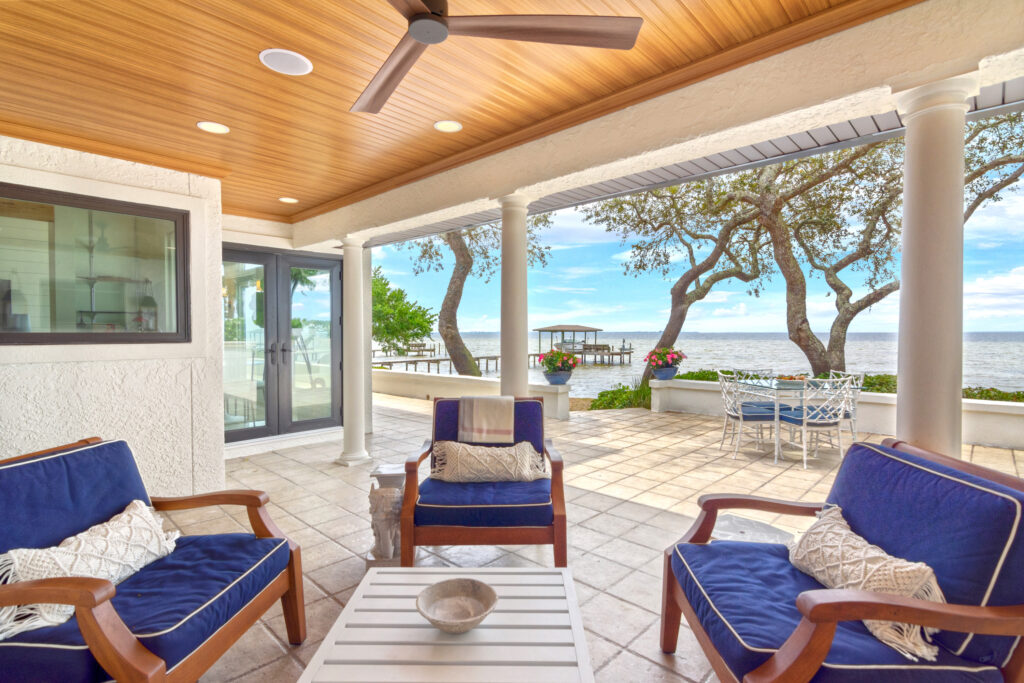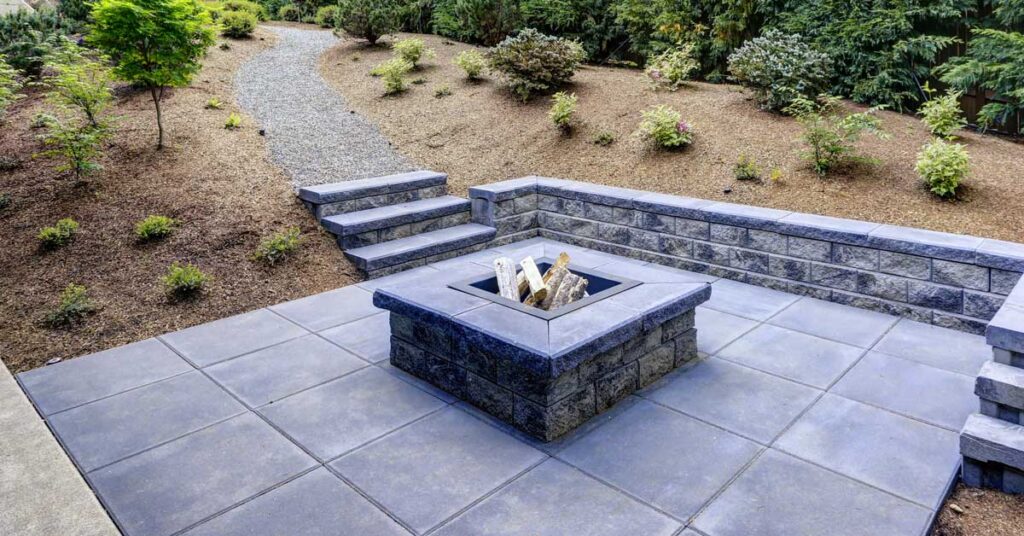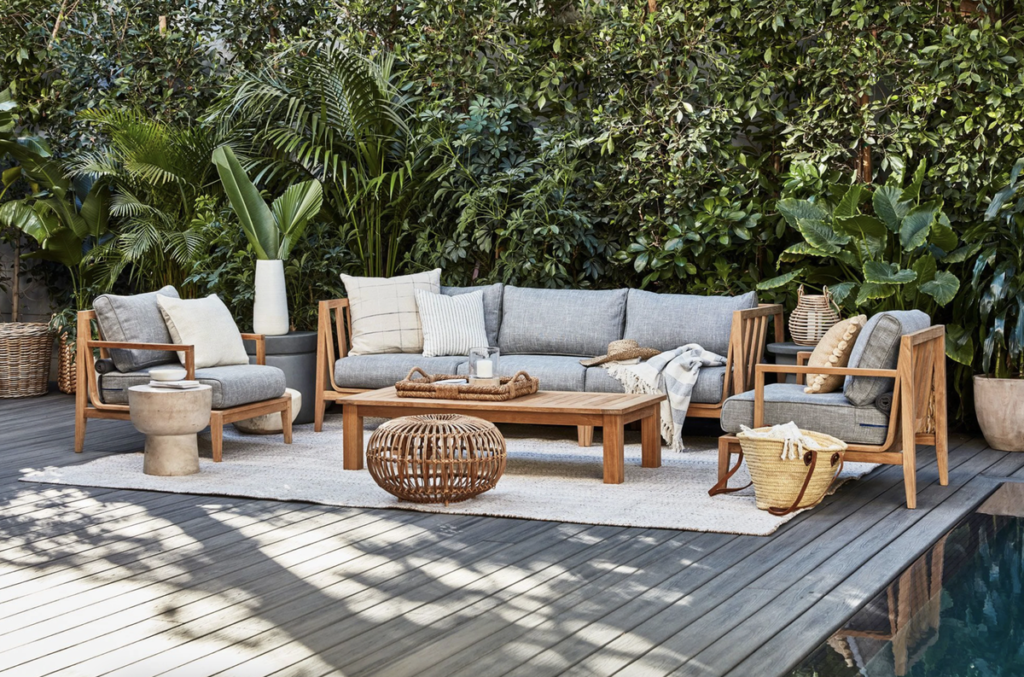Purpose of Article
The purpose of this article is to explore the various options available for outdoor patio ceilings. When designing or renovating an outdoor living space, it’s important to consider all aspects, including the ceiling. The ceiling can add visual appeal and also serve as a protective barrier from harsh weather conditions.
There are many materials to choose from when selecting a patio ceiling. Wood is a popular choice, with options such as wooden beams, stained wood, plywood panels, and wood plank ceilings. It adds a natural touch and can be stained or painted to complement the overall design. Beadboard and groove boards are also favored for their free-flowing design and timeless look. you can enhance your patio ceiling beauty by choosing right sizes of ceiling fan.
For those seeking an inexpensive option, corrugated metal and composite materials are durable and water-resistant. They can handle harsh weather conditions and require minimal maintenance. Durable fiber cement board and composite panels are also excellent choices for their moisture-resistant properties.
In addition to the practical purposes, the ceiling can also add a pop of color and curb appeal to your outdoor living space. A blue porch ceiling or leafy design can create a beautiful contrast against the surrounding nature. Coffered and v-groove designs can create a more formal look that adds sophistication and visual interest.
In conclusion, when designing or renovating an outdoor patio, the ceiling is an important aspect to consider. With a variety of materials, designs, and colors available, you’re sure to find the perfect ceiling for your outdoor living space.
Overview of Options
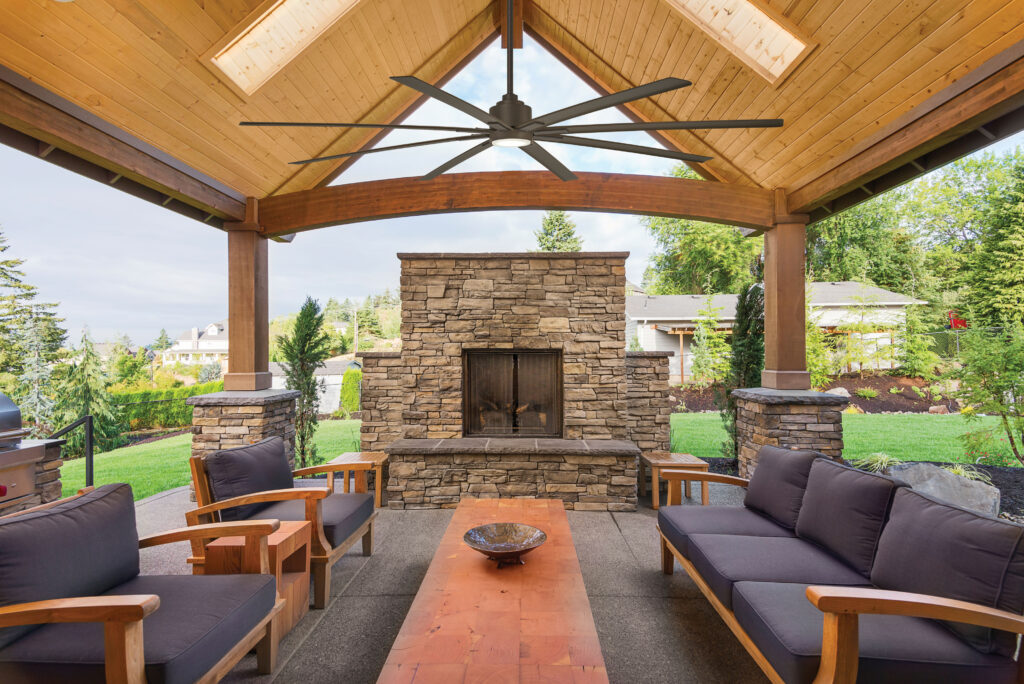
When it comes to designing your outdoor patio, one aspect that can sometimes be overlooked is the ceiling. However, the ceiling can actually have a significant impact on the overall look and feel of your outdoor space. From wood to metal to fiber cement board, there are a variety of options to choose from when it comes to selecting a patio ceiling.
Wooden ceilings are a mainstay for porch ceilings and a popular choice among homeowners. With options such as wooden beams, stained wood, plywood panels, and wood plank ceilings, wood adds a natural touch and can be stained or painted to complement the overall design. Beadboard and groove boards are also favored for their free-flowing design and timeless look.
For those seeking an inexpensive option, corrugated metal and composite materials are durable and water-resistant. They can handle harsh weather conditions and require minimal maintenance. Composite panels and durable fiber cement board are also excellent choices for their moisture-resistant properties.
In addition to practical purposes, the ceiling can also add a pop of color and curb appeal to your outdoor living space. A blue porch ceiling or leafy design can create a beautiful contrast against the surrounding nature. Coffered and v-groove designs can create a more formal look that adds sophistication and visual interest.
Ultimately, the choice of patio ceiling will depend on a number of factors, including personal preference, budget, and the overall design of your outdoor space. However, by considering the variety of materials and designs available, you can find the perfect ceiling to complete your outdoor oasis.
Types of Porch Ceilings
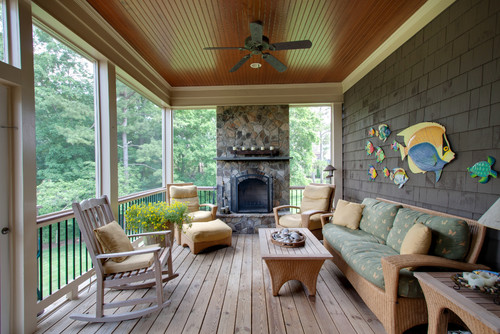
Your porch is a vital part of your home’s exterior and creating a beautiful, inviting outdoor space starts with the right kind of porch ceiling. There are various options available when it comes to choosing your porch ceiling material, design, and color. Here are some of the most popular types of porch ceilings:
Wooden Ceilings: This is the most traditional and popular type of porch ceiling. With a variety of finishes and styles ranging from stained wood, plywood panels, and wood plank ceilings, wooden ceilings and hanging string lights add a natural touch to your home’s exterior. The timeless beadboard and groove boards have a flowing design and easy on the pocketbook.
Composite Ceilings: These modern ceiling materials are durable, weather-resistant, mold and mildew-resistant, and are best suited for homes located in areas that experience high moisture. Available in a range of colors and designs, these materials can simulate the look of wood, but requires lower maintenance.
Metal Ceilings: Also known as the corrugated metal ceiling, this porch ceiling is an excellent choice for rugged and rustic homes. It is durable and weather-resistant, making it perfect for areas that experience harsh weather conditions. Metal ceilings have a unique visual appeal and add a touch of personality to your home’s exterior.
Fiber Cement Ceilings: Fiber cement is a durable material that is low-maintenance and resistant to rot, moisture, and insects. It is best suited for homeowners who want a cost-effective and visually appealing ceiling solution. This material can also resist damage from hail, and extreme weather conditions.
Painted Ceilings: If you want to add color and vibrancy to your porch ceiling, then a coat of paint is the way to go. This is an inexpensive way to give your ceiling a new look and feel. A blue porch ceiling can give your home’s exterior a touch of southern charm while a leafy design can add an element of nature to the aesthetic.
Whichever type of porch ceiling appeals to you, remember to choose a material that is durable and low maintenance to ensure longevity. With the right porch ceiling, you can transform your outdoor living space into a beautiful and inviting extension of your home.
Wooden Ceiling

Are you looking for a timeless and classic look for your outdoor patio ceiling? Consider a wooden ceiling. Wooden ceilings come in a variety of finishes and styles, ranging from stained wood to wood plank ceilings. This natural touch adds a warm and inviting feel to your home’s exterior.
Beadboard and groove boards are the most popular types of wooden ceilings and have a free-flowing design. Beadboard is a tongue-and-groove type of paneling that has a narrow strip, or “bead,” added at regular intervals to create a visual line. Groove boards are similar to beadboard, but have a V-groove design that creates an open and airy effect.
Wooden ceilings are also easy on the pocketbook. They are a cost-effective solution that can provide lasting visual appeal. Additionally, wooden ceilings can be painted or stained to match your exterior decor.
Keep in mind that wooden ceilings are not ideal for areas with high moisture levels. They may expand and contract with changes in temperature and humidity, resulting in warping or bowing. However, if your home is located in an area with moderate moisture, wooden ceilings are an excellent choice.
Overall, wooden ceilings are a mainstay for porch ceilings and have been for centuries. They provide a natural touch and a timeless feel that adds value and aesthetic appeal to your home’s exterior.
Coffered Ceilings
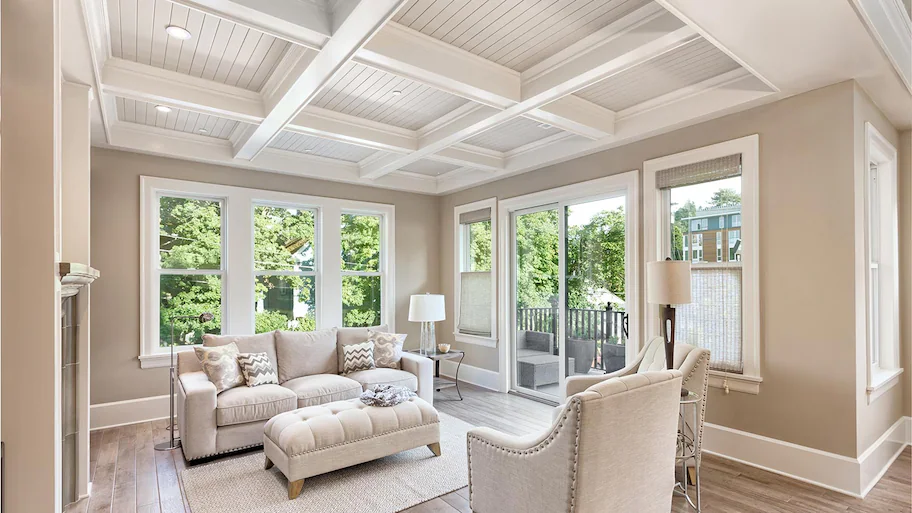
Coffered ceilings are an elegant and sophisticated addition to any home or outdoor living space. They add a touch of visual appeal while also providing a practical function by reducing noise levels and creating an illusion of height in a room.
Coffered ceilings are composed of a series of sunken panels that are either square or rectangular in shape. These panels are surrounded by ornate moldings and beams that add to the overall appearance of the ceiling. They can be made from a variety of materials such as wooden beams, fiber cement board, or even corrugated metal panels.
One of the benefits of coffered ceilings is that they can be customized to fit any space or decor style. They are available in a variety of colors and materials, allowing homeowners to choose the perfect look for their outdoor living space. Coffered ceilings can also be designed to fit any room size, making them a versatile and adaptable choice for any home.
Coffered ceilings are also a durable choice for outdoor living spaces. They are water-resistant and able to withstand harsh weather conditions, making them a practical choice for homes located in areas with high humidity or frequent rainfall. Additionally, they are easy to maintain and require a simple coat of paint to freshen up their appearance.
If you’re looking for a way to add visual appeal to your outdoor living space while also reducing noise levels and creating an illusion of height, consider installing a coffered ceiling. This stunning and practical feature is sure to become a mainstay for your outdoor space, adding beauty and value to your home for years to come.
Groove Porch Ceilings

Groove porch ceilings provide a beautiful and classic design option for any outdoor living space. These ceilings are made up of tongue and groove boards that interlock to create a seamless and free-flowing design. Groove porch ceilings are a mainstay for ceilings, providing a stunning visual appeal and enhancing the overall curb appeal of your outdoor space.
The groove design also serves a functional purpose, as it allows for the natural expansion and contraction of the wood due to changes in temperature and humidity. This ensures that your porch ceiling remains structurally stable and looks beautiful for years to come.
There are a variety of materials that can be used for groove porch ceilings, including wood, composite materials, and durable fiber cement board. Some popular choices include stained wood for a warm and natural look or composite panels that are moisture resistant and easy to maintain.
For a unique and eye-catching look, homeowners can experiment with different colors and finishes for their groove porch ceiling. A blue porch ceiling, for example, is a traditional design choice in the southern United States and adds a pop of color to your outdoor living space.
Inexpensive porch ceiling ideas can also be achieved with a groove porch ceiling. Plywood panels can be used as a budget-friendly option, while still providing the classic and timeless look of a groove porch ceiling.
Overall, a groove porch ceiling is an excellent choice for anyone looking to enhance their outdoor living space. Its durability, variety of materials, and customizable design options make it a popular and beautiful choice for any porch design.
Beadboard Ceiling
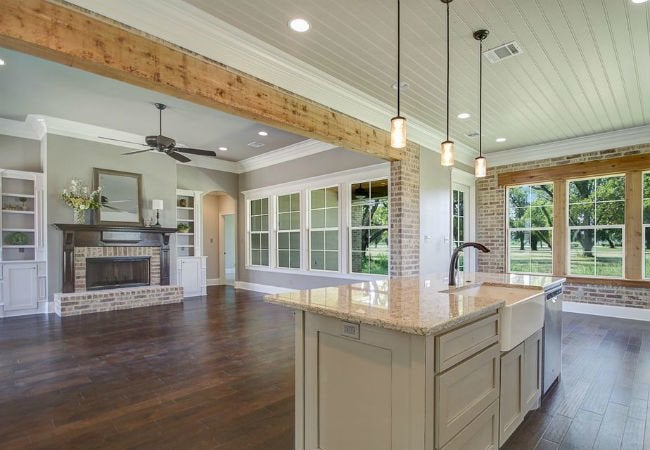
One of the most popular choices for outdoor patio ceilings is the beadboard ceiling. Beadboard is a type of tongue-and-groove paneling that features a distinctive pattern of narrow vertical grooves or ridges, typically accented by shallow ridges running perpendicular to the grooves.
Beadboard is a great choice for outdoor ceilings for a variety of reasons. Firstly, it adds visual appeal and texture to outdoor living spaces, giving them a cozy and welcoming feel. It comes in a variety of materials, including wood, PVC, composite, and fiber cement, so homeowners can choose the option that best suits their budget and design preferences.
In addition to being beautiful, beadboard is also functional. It is water-resistant, making it perfect for withstanding harsh weather conditions and preventing mold growth. It is also relatively easy to install, which makes it a popular choice for DIY home improvement projects.
One popular variation of the beadboard ceiling is the V-groove design. The V-groove design features a wider groove and a more pronounced angle, which gives the ceiling a more free-flowing design. This type of ceiling is perfect for outdoor spaces where you want a more relaxed and informal atmosphere.
Another great thing about beadboard is that it can be painted or stained in a variety of colors to match any décor scheme. For a classic and traditional look, choose a coat of crisp white paint. For a more contemporary look, experiment with bolder colors or muted tones.
Whether you choose a beadboard ceiling for its visual appeal, water-resistant qualities, or easy installation, it is sure to be a beautiful and durable addition to any outdoor patio or porch ceiling.
V-Groove Design
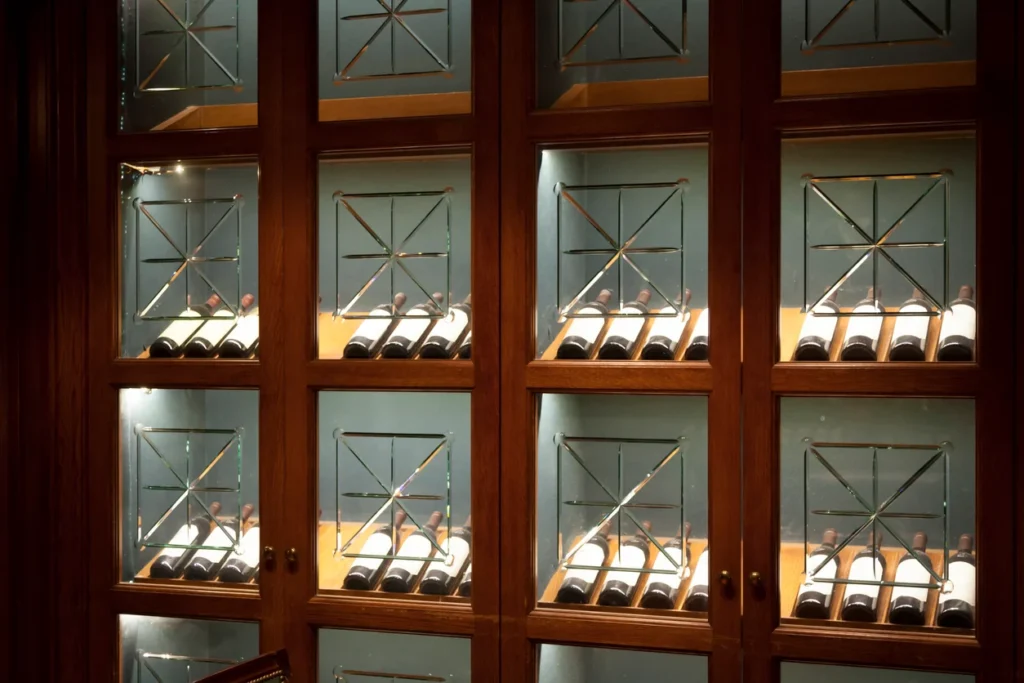
V-groove design is a popular option for outdoor ceilings that adds character, charm, and visual interest to your space. This design features wider grooves and pronounced angles that create a free-flowing effect, giving your ceiling a relaxed and informal ambiance.
This design is an excellent choice for homeowners who are looking to create a unique and timeless look and feel for their outdoor space. V-groove design is versatile and can be made using a variety of materials, including wood, PVC, composite, fiber cement, and even metal.
Wooden v-groove ceilings are a classic and popular option that can add warmth and natural beauty to your outdoor area. Wooden beams, for instance, can be used to create a coffered ceiling, which adds depth and texture to the overall design. A wooden v-groove ceiling can also be stained in a variety of colors, such as natural wood tones or darker hues, to match any style of decor.
For those looking for a more modern and sleek look, composite materials such as PVC and fiber cement offer a durable and cost-effective alternative to traditional hardwood. These materials can be formed into any desired shape and are moisture-resistant, making them ideal for areas with frequent rain or high humidity.
Those who prefer an even more unique look can opt for a corrugated metal v-groove ceiling. The metallic texture provides a rugged aesthetic that adds an industrial feel to your outdoor space. This option is also durable and resistant to the elements, making it an excellent choice for harsh weather conditions.
In conclusion, a v-groove ceiling design can enhance the visual appeal of your outdoor space and make it more inviting. It provides a versatile and flexible option that can be designed using a variety of materials, colors, and groove widths. So, whether you’re looking for a timeless classic look or a modern, innovative design, a v-groove ceiling can be the perfect addition.
Wooden Beams

Wooden beams are a classic and versatile addition to any home. These structural elements offer both functional support and aesthetic appeal, adding texture and warmth to any space they occupy.
When it comes to outdoor patios, wooden beams can be used in a variety of creative ways to create a visually stunning and inviting atmosphere. One popular option is to incorporate wooden beams into a coffered ceiling design, which features a series of recessed panels that provide depth and dimension to the ceiling. This design can be further enhanced by using a v-groove pattern on the wooden beams, which adds an extra layer of interest and texture.
In addition to coffered ceilings, wooden beams can be used to create a rustic or farmhouse-style look. For instance, rough-hewn wooden beams can be left exposed and paired with a wooden plank ceiling for a cozy and inviting ambiance. Alternatively, wooden beams can be used as supports for a pergola or other outdoor structure, adding stability and strength to the design.
When it comes to selecting the right type of wood for your beams, there are several options to consider. Cedar and redwood are popular choices due to their natural resistance to decay and insects, as well as their attractive, reddish-brown color. For a more rustic look, reclaimed or salvaged wood can be used to add a weathered and worn quality to the space.
Ultimately, wooden beams offer a timeless and versatile option for adding character and charm to any outdoor patio. Whether used as structural support or simply for visual interest, these elements can add warmth, texture, and a sense of history to any space.
Materials for Porch Ceilings
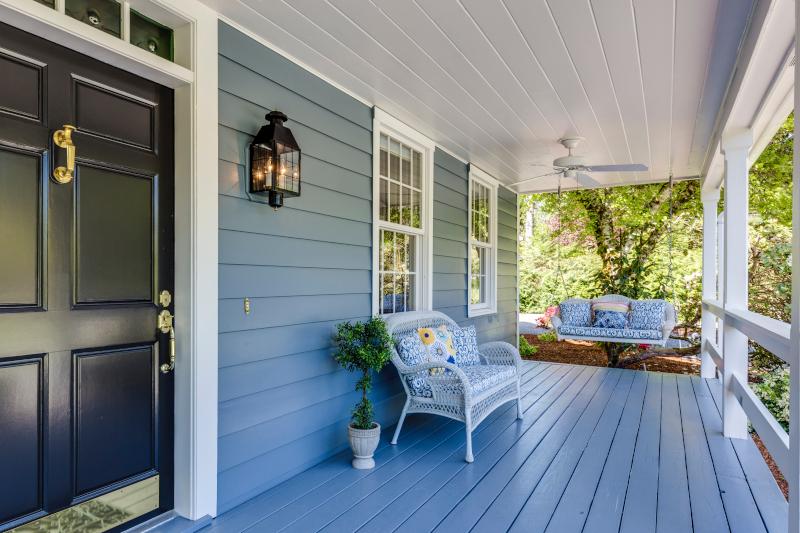
When it comes to designing an outdoor living space, the porch is the perfect place to relax and unwind. However, the ceiling of your porch is just as important as the flooring and walls, as it can impact the overall style and mood of the space. When selecting materials for porch ceilings, it’s essential to consider the look you want to achieve, the durability of the material, and its ability to resist harsh weather conditions.
One popular choice for porch ceilings is wood. Wooden materials, such as pine or cedar, can be used to create a cozy and inviting ambiance. Wood ceilings also offer a wide variety of design options, such as coffered and v-groove designs. Cedar and redwood are particularly favored due to their natural resistance to insects and decay.
Another wood option is composite materials, which are comprised of a mixture of wood and plastic. These materials are an excellent choice for those who want the look of wood but with added durability and resistance to moisture. Composite materials are also available in a variety of colors and textures, which makes them an attractive choice for porch designs.
For a more modern look, metal ceilings are becoming increasingly popular. Corrugated metal, in particular, is gaining favor due to its industrial yet sleek appearance. Metal ceilings are durable and resistant to water damage, making them a great option for outdoor living spaces.
For a classic and timeless look, beadboard ceilings are always a popular choice. These panels can come pre-finished, which eliminates the need for a coat of paint, or can be painted to match the color scheme of your porch. Beadboard ceilings pair well with traditional and farmhouse style designs.
Finally, fiber cement boards, such as Hardie board, offer a durable and moisture-resistant option for porch ceilings. These boards are typically used for exterior siding but can also be installed on ceilings for a cohesive look. They are available in a variety of finishes, including smooth and textured, and can be painted to match your porch’s design.
In summary, when selecting materials for a porch ceiling, there are a variety of options to consider, from wood and composite materials to metals and fiber cement boards. Each material has its pros and cons, so it’s important to weigh the factors that are most important to you, such as visual appeal and durability, before making a final decision.
Wood
Wood is a timeless and versatile building material that has been used for centuries. It is a popular choice for both indoor and outdoor applications, including flooring, furniture, and even structural supports. One of the most appealing qualities of wood is its natural beauty. Each piece is unique, with its own grain and color, which adds warmth and character to any space.
Wood is also durable and long-lasting, especially if it is properly treated and maintained. Cedar and redwood, for example, are naturally resistant to insects and decay, making them excellent choices for outdoor projects such as decks and pergolas. Hardwoods like oak and maple are known for their strength and durability, and can withstand heavy use and wear over time.
In addition to its aesthetic and durability qualities, wood is also a sustainable material. It is renewable, meaning that trees can be replanted and harvested for wood products, unlike non-renewable materials like plastics and metals. Proper forestry management practices ensure that only a small percentage of forests are harvested each year, ensuring that we have a continuous supply of wood for generations to come.
Overall, wood is an excellent choice for both practical and aesthetic purposes. It offers a natural beauty and warmth that simply cannot be replicated by synthetic materials, and when cared for properly, can last a lifetime. So whether you’re building a new porch or looking to add some character to your home’s interior, consider wood as a material option.

